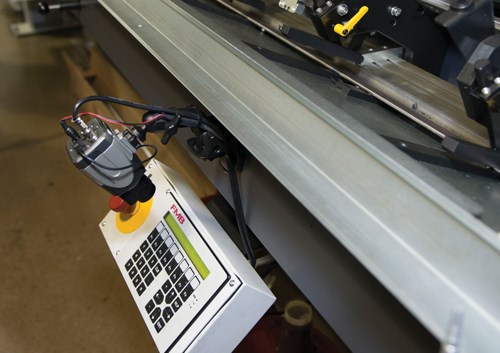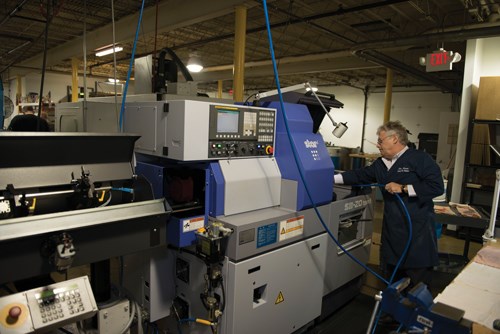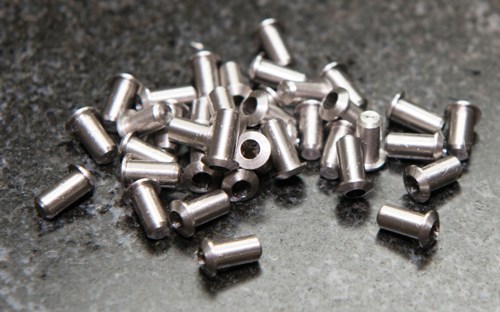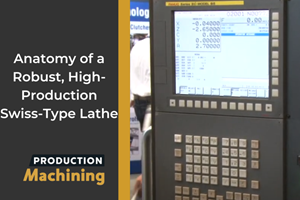Running Remotely
Everybody talks about unattended machining operations and many have implemented it in varying degrees. Since day one, this Dayton, Ohio shop has never operated any other way.
One might say Mike Mauro is living his dream. He is president of Southwest Ohio Swiss Turn, an LLC located in Dayton, Ohio, and while running his own business is part of the dream, the way he runs his shop reflects fulfillment of an idea he fostered after many years in precision machined parts manufacturing.
Mr. Mauro’s metalworking career began 30 years ago working with his dad who was a screw machine machinist. “We ran various automatic cam machines, both single spindles and multi-spindles, and I spent many hours learning the ins and outs of automatic screw machine operation,” Mr. Mauro says. “I actually wasn’t exposed to Swiss turn until June 2010. However, my experience with screw machining and conventional CNC machine processes is what directed me toward Swiss turn machining.”
For Mr. Mauro there was no comparison between Swiss machine capability and conventional turning centers. “The accuracy and ability to combine operations to produce parts complete was a no-brainer,” Mr. Mauro says. “The machine’s main and subspindle combination for machining Op10 and Op 20 in a single handling, as well as turn/mill capability, make the Swiss-type ideally suited for unattended operations.”
This fundamental knowledge grew with experience and adapted as the technology of machining precision parts moved forward. Programming CNC machine tools and learning about new tooling advancements as well as process improvements became graduate courses over time for Mr. Mauro.
This advanced degree in metalworking production that Mr. Mauro has earned is the foundation for Southwest Ohio Swiss Turn, which opened its doors in January 2012. However Mr. Mauro’s metalworking chops are only a part of the equation for this business.
From Day One
Many shops looking to lower costs are adding unattended shifts to the shop’s production mix. Mr. Mauro has the advantage creating his unattended system from scratch.
“For many shops, trying to get the labor costs down is a key to being competitive,” he says. “However, these shops are often dealing with legacy issues and company cultural biases that can make such changes difficult. “I’m blessed with a clean slate and believe that running unattended as much as possible is the future. My plan is to organically grow an unattended machining operation from the beginning.”
In what is probably the leanest machine shop operation possible, Mr. Mauro has a single Star SB 20 Type E with an FMB magazine bar feeder on his shop floor. Actually it’s not even his shop floor—rather subleased space from another machine shop. Moreover, Mr. Mauro is the only employee.
One of Mr. Mauro’s first jobs was an overflow part for another shop in 303 stainless. The run was 16,000 pieces, and the tolerance was plus/minus 2 tenths.
“After getting the tooling right, I was able to run that part unattended and hold the tolerance,” Mr. Mauro says. “It was a great proof of concept because I knew they were going to pull the work back in-house, but it gave me the opportunity to test the idea of running parts unattended.
“In order to run the job unattended and still monitor what was happening, I had Mark Crumbacher of Custom Connections Audio Video Ltd. install cameras on the machine and link those to remote monitors in my office,” Mr. Mauro says. “I can even use my cell phone to watch the shop when I’m not on site. I finished running that first job unattended, and since then the majority of jobs have run unattended.”
Another example Mr. Mauro shared with us was a fastener part he was just finishing up when we visited. The order was for 90,000 pieces, and Mr. Mauro ran the order in 4 weeks. “Last week I ran the Star 144 hours and wasn’t in front of the machine more than 10 hours total,” says Mr. Mauro. Most of that 10 hours was replenishing the magazine bar feeder, which has a camera trained on its control panel to alert Mr. Mauro when the stock is running low.
Multitasking
The unattended operation Mr. Mauro has built allows time for the many other tasks needed to run a business. Three different views including the shop, machine and bar feeder are available to Mr. Mauro as he sits at his desk or on his mobile phone. His office is on the second floor and not close to the shop floor.
Not being physically tethered to the shop floor allows Mr. Mauro the freedom to visit customers, solicit more work for his shop, and even make deliveries. Moreover, he can do production planning, purchasing, traceability documentation, quality plans and programming while the machine is making good parts.
Labor Ratio
Having gained experience working with the machine and the unattended concept and successfully running more than 100 hours unattended a week, Mr. Mauro believes he could operate up to three such machines. “Can you imagine,” he says, “running 300 hours per week with no labor costs except my own?”
That 300-hour run time is the basis for Mr. Mauro’s growth strategy. He believes the unattended system he is using will scale up. “I think I could run ten CNC Swiss machines with fewer than five employees,” he speculates. “That would translate to 300 hours of output for 40 hours of labor, and that’s the production/labor ratio I want to hit.”
Currently, Mr. Mauro doesn’t run 24 hours because the machine does not have a chip conveyor. “I come in around 6:30 in the morning, clear the chips and begin the day’s run,” he says. “The machine then operates until about 5 a.m., so it’s not really 24 hours, but close. I do the same thing on the weekend, then go home and watch football while the machine makes parts.”
An important aspect of Mr. Mauro’s business model for SW Ohio Swiss is that he doesn’t look at hourly shop rates as a metric. Rather, he uses weekly revenue.
He puts it this way: “I look at my cost. Hourly rate doesn’t matter because I know I’m running 2nd and 3rd shifts unattended. If I pay myself for 40 hours, get 100 hours of production on the floor and spend 10 hours tending the machine, I get an “hourly rate” very competitive with bigger shops, very quickly. And the quality of parts coming off the Star is better than many.”
Picking the Right Job
“Obviously some jobs are better suited to unattended operations than others,” Mr. Mauro says. “Much of my job planning involves making sure the machinability of the material is such that I can get reasonable tool life. I generally try not to run anything much tougher that 304 stainless. Also, the tolerance requirements of the job determine when to use ground stock. Usually, I specify ground stock for tolerances below plus/minus 5 tenths.”
As for workpiece size, the Star machine has 20-mm maximum diameter, so the barstock must fit within that upper range. Mr. Mauro’s FMB magazine bar feeder has a capacity of 42 bars (based on using ¼-inch diameter stock) and depending on the workpiece length and cycle time can last up to 4 days of unattended machining before needing to be reloaded. With one of his cameras focused on the bar feeder display panel, capacity status of the unit is easily monitored remotely.
One of the goals for unattended machining is trying to seek balance between the operations performed on the main spindle and the subspindle. Mr. Mauro mentioned one job he ran that has more backworking operations than frontworking.
“On this job,” Mr. Mauro tells us, “I slowed down the feeds and speeds on the main spindle turning operations. Going faster wouldn’t make any time difference because the backworking operations controlled the cycle time. By better balancing the cutting times between the two spindles, my tooling life increased significantly, allowing me to get 18,000 parts from each side of two-sided insert. Unattended machining is all about trying to eliminate the need for intervention as much as possible before running the job. And, with every job, I get better at it.”
The Process
Like most shops, a job for SW Ohio Swiss Turn comes in from the customer as a CAD file or drawing. As a one-man show, the first thing Mr. Mauro does is redraw the part and determine the points for tool path. That leads him to the programming needed on the Star to make the workpiece. Of course, this activity is happening as the machine is making a previous job.
“Once I have the program written and the numbered quality plan drawing is complete, I generate my first article report. This report, along with the receiving and final inspection reports, correspond with the quality plan drawing,” Mr. Mauro says. “That, along with a final article inspection becomes part of the job packet, which includes the router and various inspection details. I will supply a first article to the customer, if requested. Once the job is issued, I order material and schedule the run. My current turnaround is about 4 weeks, but it’s getting better as I get better with the machine.”
Now is the Time
According to Mr. Mauro, the impetus for starting his machine shop business is built around the idea of making the part right and having the discipline to trust the technology will manufacture good parts if the front end work is done correctly, which means elimination of much of the overhead of a traditional shop structure. This is the founding concept that Mr. Mauro has implemented in his shop.
The advances in machine tool technology, such as the Star CNC Swiss machine, are at a point where the accuracy, reliability and flexibility enable a good machinist to make virtually anything—and make it right. Now, add the convenience of the Internet and WiFi to the mix, and the ability to run a shop remotely becomes a real possibility.
“Please don’t get me wrong—not every job is a candidate for my manufacturing system,” Mr. Mauro says. “That’s where discipline comes in. However, I believe there is enough work available from OEMs and occasionally other machine shops to create a viable business using unattended machining and lean principles as the model. Granted, I’ve only been at this for a year, but so far it is working.”
Related Content
Software Controls Chip Breaking in Thread Turning Operations
This cutting tool manufacturer has developed a software module for chip control of thread turning operations in virtually any CNC lathe, even for older machines, using specific tooling and software.
Read MoreVideo Tech Brief: Anatomy of a Robust, High-Production Swiss-Type Lathe
This Swiss-type is equipped with a total of 52 tools, including a 40-tool magazine, 10 tools on the back tool post, and an optional 2 tools on the deep hole drill holder.
Read MoreAutomation Breakthroughs Revolutionize Precision Machining for Complex Parts
Marubeni Citizen-Cincom delivers custom solutions to address some of the biggest challenges in precision machining from handling small parts, to robot integration and unique tooling needs.
Read MoreSwiss Rejuvenation Doubles Shop Productivity
As he progressed to CNC Swiss lead and later to his current position as CNC Swiss production supervisor, Darrin Baker helped the Swiss department at Liberty Precision double its productivity, according to his nominator.
Read MoreRead Next
Stepping Up to Unattended Machining
Lights out, unattended machining is a goal for many precision machined parts manufacturers. For many parts using easily machined materials, the process is fairly straightforward. However, this Ohio shop uses a systematic process to maximize unattended machining of more difficult materials.
Read More5 Aspects of PMTS I Appreciate
The three-day edition of the 2025 Precision Machining Technology Show kicks off at the start of April. I’ll be there, and here are some reasons why.
Read MoreSeeing Automated Workpiece Measurement in Real Time
User-friendly inspection software for CNC machining centers was shown at IMTS 2024 monitoring measurements between and after machining while performing SPC based on recorded measurement values.
Read More















.jpg;maxWidth=300;quality=90)









